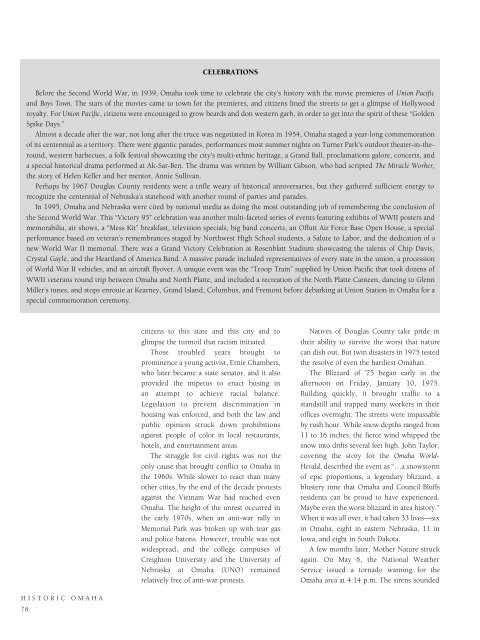Historic Omaha
An illustrated history of Omaha and the Douglas County area, paired with the histories of companies, families and organizations that make the region great.
An illustrated history of Omaha and the Douglas County area, paired with the histories of companies, families and organizations that make the region great.
Create successful ePaper yourself
Turn your PDF publications into a flip-book with our unique Google optimized e-Paper software.
CELEBRATIONS<br />
Before the Second World War, in 1939, <strong>Omaha</strong> took time to celebrate the city’s history with the movie premieres of Union Pacific<br />
and Boys Town. The stars of the movies came to town for the premieres, and citizens lined the streets to get a glimpse of Hollywood<br />
royalty. For Union Pacific, citizens were encouraged to grow beards and don western garb, in order to get into the spirit of these “Golden<br />
Spike Days.”<br />
Almost a decade after the war, not long after the truce was negotiated in Korea in 1954, <strong>Omaha</strong> staged a year-long commemoration<br />
of its centennial as a territory. There were gigantic parades, performances most summer nights on Turner Park’s outdoor theater-in-theround,<br />
western barbecues, a folk festival showcasing the city’s multi-ethnic heritage, a Grand Ball, proclamations galore, concerts, and<br />
a special historical drama performed at Ak-Sar-Ben. The drama was written by William Gibson, who had scripted The Miracle Worker,<br />
the story of Helen Keller and her mentor, Annie Sullivan.<br />
Perhaps by 1967 Douglas County residents were a trifle weary of historical anniversaries, but they gathered sufficient energy to<br />
recognize the centennial of Nebraska’s statehood with another round of parties and parades.<br />
In 1995, <strong>Omaha</strong> and Nebraska were cited by national media as doing the most outstanding job of remembering the conclusion of<br />
the Second World War. This “Victory 95” celebration was another multi-faceted series of events featuring exhibits of WWII posters and<br />
memorabilia, air shows, a “Mess Kit” breakfast, television specials, big band concerts, an Offutt Air Force Base Open House, a special<br />
performance based on veteran’s remembrances staged by Northwest High School students, a Salute to Labor, and the dedication of a<br />
new World War II memorial. There was a Grand Victory Celebration at Rosenblatt Stadium showcasing the talents of Chip Davis,<br />
Crystal Gayle, and the Heartland of America Band. A massive parade included representatives of every state in the union, a procession<br />
of World War II vehicles, and an aircraft flyover. A unique event was the “Troop Train” supplied by Union Pacific that took dozens of<br />
WWII veterans round trip between <strong>Omaha</strong> and North Platte, and included a recreation of the North Platte Canteen, dancing to Glenn<br />
Miller’s tunes, and stops enroute at Kearney, Grand Island, Columbus, and Fremont before debarking at Union Station in <strong>Omaha</strong> for a<br />
special commemoration ceremony.<br />
citizens to this state and this city and to<br />
glimpse the turmoil that racism initiated.<br />
Those troubled years brought to<br />
prominence a young activist, Ernie Chambers,<br />
who later became a state senator, and it also<br />
provided the impetus to enact busing in<br />
an attempt to achieve racial balance.<br />
Legislation to prevent discrimination in<br />
housing was enforced, and both the law and<br />
public opinion struck down prohibitions<br />
against people of color in local restaurants,<br />
hotels, and entertainment areas.<br />
The struggle for civil rights was not the<br />
only cause that brought conflict to <strong>Omaha</strong> in<br />
the 1960s. While slower to react than many<br />
other cities, by the end of the decade protests<br />
against the Vietnam War had reached even<br />
<strong>Omaha</strong>. The height of the unrest occurred in<br />
the early 1970s, when an anti-war rally in<br />
Memorial Park was broken up with tear gas<br />
and police batons. However, trouble was not<br />
widespread, and the college campuses of<br />
Creighton University and the University of<br />
Nebraska at <strong>Omaha</strong> (UNO) remained<br />
relatively free of anti-war protests.<br />
Natives of Douglas County take pride in<br />
their ability to survive the worst that nature<br />
can dish out. But twin disasters in 1975 tested<br />
the resolve of even the hardiest <strong>Omaha</strong>n.<br />
The Blizzard of ’75 began early in the<br />
afternoon on Friday, January 10, 1975.<br />
Building quickly, it brought traffic to a<br />
standstill and trapped many workers in their<br />
offices overnight. The streets were impassable<br />
by rush hour. While snow depths ranged from<br />
11 to 16 inches, the fierce wind whipped the<br />
snow into drifts several feet high. John Taylor,<br />
covering the story for the <strong>Omaha</strong> World-<br />
Herald, described the event as “…a snowstorm<br />
of epic proportions, a legendary blizzard, a<br />
blustery time that <strong>Omaha</strong> and Council Bluffs<br />
residents can be proud to have experienced.<br />
Maybe even the worst blizzard in area history.”<br />
When it was all over, it had taken 33 lives—six<br />
in <strong>Omaha</strong>, eight in eastern Nebraska, 11 in<br />
Iowa, and eight in South Dakota.<br />
A few months later, Mother Nature struck<br />
again. On May 6, the National Weather<br />
Service issued a tornado warning for the<br />
<strong>Omaha</strong> area at 4:14 p.m. The sirens sounded<br />
HISTORIC OMAHA<br />
78
















